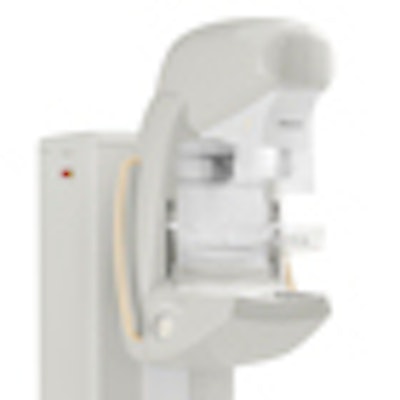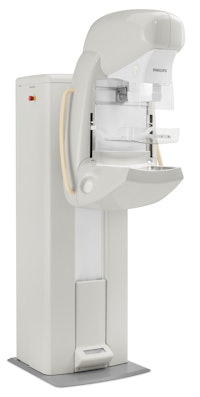
For years, Philips Healthcare watched the U.S. mammography market from the sidelines, even as it has expanded its presence in other modalities. That's changed as the vendor begins U.S. sales of a new full-field digital mammography (FFDM) system, based on a unique photon-counting technology.
Philips gained the MicroDose Mammography system technology when it bought Swedish PACS firm Sectra's mammography business last fall. Philips acquired the MicroDose technology to round out its portfolio of imaging equipment, according to Sankar Suryanarayanan, PhD, Philips' global marketing director for mammography.
"In the past few years we've made a commitment to women's health, and we think breast health is critically important," Suryanarayanan told AuntMinnie.com. "Mammography is one of the most widely used modalities in a screening environment, and we felt we needed to have a place in the market."
 Philips' MicroDose Mammography system. Image courtesy of Philips.
Philips' MicroDose Mammography system. Image courtesy of Philips.
With the launch of MicroDose, Philips is tackling more established players with dominant market shares. But the company believes its MicroDose technology will differentiate the firm from its competitors by offering lower radiation dose and minimized scatter.
Conventional digital approaches to full-field digital mammography operate under a mechanism called energy integration, which integrates all the photons in a detector to create an image, Suryanarayanan said. In contrast, MicroDose's photon-counting detector counts each x-ray one by one and eliminates a number of intermediate steps required to convert an x-ray into a digital image that can contribute to data loss.
Photon-counting technology enables MicroDose to virtually eliminate electronic noise and scatter radiation; plus, it allows equal weighting of low- and higher-energy x-rays, which enables low-radiation-dose imaging without compromising image quality, according to Suryanarayanan. And the device's SmartAEC optimizes radiation exposure depending on the density of the breast, without the need for a pre-exposure shot, Suryanarayanan said.
MicroDose also does away with the need for a magnification stand for diagnostic views. With 50-micron resolution, radiologists can identify a point of interest, scan that region alone, and then digitally magnify it.
Philips is working on a spectral mammography platform for MicroDose that would quantify breast density; the company hopes to launch the platform at this year's RSNA 2012 meeting, Suryanarayanan said. Philips is also working on validating spectral technology to categorize breast lesions.
Philips has more than 300 MicroDose units installed across Europe and Australia, including more than 30 mobile truck installs, according to Suryanarayanan.
User experience
United Medical Center (UMC) of Washington, DC, has installed MicroDose in its new women's health wing. Until last year, UMC's mammography services were using still film-screen technology, according to Dr. Raymond Tu, chair of UMC's radiology department. UMC supports women in underserved communities of Washington, DC, and Maryland.
"There was an opportunity to transition to a new technology, and the fact that MicroDose's radiation dose is 50% less than other FFDM units was attractive," Tu told AuntMinnie.com. "The women we serve often are obese and need more mammography exposures to cover the whole breast. So the radiation savings MicroDose offers made sense."




















